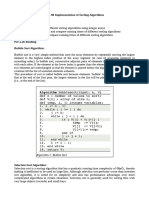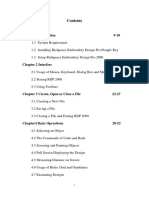Advantages
Uploaded by
Aubrey SanchezAdvantages
Uploaded by
Aubrey SanchezAUBREY C.
SANCHEZ BSIT – 2B DATA STRUCTURES AND ALGORITHMS
Merge sort is a popular sorting algorithm known for its efficiency in sorting lists or arrays. It follows the divide-and-
conquer approach, breaking down the input into smaller parts, sorting those parts, and then merging them back
together in a sorted manner.
Explanation of how merge sort typically works:
1. Divide: The algorithm divides the input array into smaller subarrays until each subarray contains only one element.
This process continues until there's no further way to divide the array.
2. Conquer: Once the array is divided into individual elements (which are inherently sorted), the algorithm starts
merging and sorting adjacent pairs of subarrays. It compares elements from each pair and arranges them in order.
3. Merge: As the sorting progresses, the sorted subarrays are merged back together in a way that maintains the sorted
order. This merging process involves comparing elements from the subarrays and placing them in the correct order into
a new merged array.
4. Repeat and combine: The merging and sorting continue until all the subarrays are merged
back into a single sorted array.
The key step in merge sort is the merging process, where two sorted subarrays are
combined into a single sorted array. This is done by comparing elements from each
subarray and arranging them in the correct order.
Overall, the divide-and-conquer strategy and the merging technique are the core
concepts behind merge sort, allowing it to efficiently sort arrays while maintaining
stability and consistent performance.
Advantages
1. Efficiency: Merge sort has a consistent time complexity of O(n log n) for the average, best, and worst cases. This
efficiency makes it highly suitable for sorting large datasets.
2. Stable Sorting: Merge sort is stable, meaning it maintains the relative order of equal elements. This property is
essential in certain applications where maintaining the original order of equal elements is necessary.
Disadvantages
1. Extra Space: Merge sort requires additional space proportional to the size of the input array for the merging process.
This might be a disadvantage when dealing with very large datasets in memory-constrained environments.
2. Not In-Place: It's not an in-place sorting algorithm. It needs additional memory equal to the size of the input array for
the merging step. Algorithms that are in-place, like QuickSort, might be preferred in situations where memory is a
concern.
I would choose merge sort because of its efficient time complexity and stability making it a strong choice for sorting
large datasets where additional space and non-in-place operations are acceptable. It allows me to organize data without
worrying for larger memory allocation because it caters more data than other sorting algorithms. It is also beneficial for
when you organize data for a short amount of time since it is fast and efficient that it does not waste time.
You might also like
- Hourglass Workout Program by Luisagiuliet 276% (21)Hourglass Workout Program by Luisagiuliet 251 pages
- The Hold Me Tight Workbook - Dr. Sue Johnson100% (16)The Hold Me Tight Workbook - Dr. Sue Johnson187 pages
- Read People Like A Book by Patrick King-Edited62% (66)Read People Like A Book by Patrick King-Edited12 pages
- Livingood, Blake - Livingood Daily Your 21-Day Guide To Experience Real Health77% (13)Livingood, Blake - Livingood Daily Your 21-Day Guide To Experience Real Health260 pages
- COSMIC CONSCIOUSNESS OF HUMANITY - PROBLEMS OF NEW COSMOGONY (V.P.Kaznacheev,. Л. V. Trofimov.)94% (212)COSMIC CONSCIOUSNESS OF HUMANITY - PROBLEMS OF NEW COSMOGONY (V.P.Kaznacheev,. Л. V. Trofimov.)212 pages
- Donald Trump & Jeffrey Epstein Rape Lawsuit and Affidavits83% (1016)Donald Trump & Jeffrey Epstein Rape Lawsuit and Affidavits13 pages
- The 36 Questions That Lead To Love - The New York Times94% (34)The 36 Questions That Lead To Love - The New York Times3 pages
- The 36 Questions That Lead To Love - The New York Times95% (21)The 36 Questions That Lead To Love - The New York Times3 pages
- Jeffrey Epstein39s Little Black Book Unredacted PDF75% (12)Jeffrey Epstein39s Little Black Book Unredacted PDF95 pages
- The 4 Hour Workweek, Expanded and Updated by Timothy Ferriss - Excerpt23% (954)The 4 Hour Workweek, Expanded and Updated by Timothy Ferriss - Excerpt38 pages
- Ineo+ - 224e - 284e - 364e - 454e - 554e - Product Guide - e - 130211 - FNo ratings yetIneo+ - 224e - 284e - 364e - 454e - 554e - Product Guide - e - 130211 - F48 pages
- Comparison of Parallel Quick and Merge Sort Algorithms On Architecture With Shared MemoryNo ratings yetComparison of Parallel Quick and Merge Sort Algorithms On Architecture With Shared Memory6 pages
- LEARNING MATERIALS-Algorithm-UNIT2 [MODIFIED]No ratings yetLEARNING MATERIALS-Algorithm-UNIT2 [MODIFIED]63 pages
- Merge Sort: Merge Sort Is Defined As A: Sorting AlgorithmNo ratings yetMerge Sort: Merge Sort Is Defined As A: Sorting Algorithm12 pages
- [2024+Issue]+National+Conference_7514269++-++JPT+--+AL+--No ratings yet[2024+Issue]+National+Conference_7514269++-++JPT+--+AL+--6 pages
- Cluster Is A Group of Objects That Belongs To The Same ClassNo ratings yetCluster Is A Group of Objects That Belongs To The Same Class12 pages
- Sorting Arranges The Numerical and Alphabetical Data Present in A List in A Specific Order orNo ratings yetSorting Arranges The Numerical and Alphabetical Data Present in A List in A Specific Order or4 pages
- Bwu - Bta - 22 - 416 - Subrata Dhara BtaNo ratings yetBwu - Bta - 22 - 416 - Subrata Dhara Bta12 pages
- Comparative Analysis of BIRCH and CURE Hierarchical Clustering Algorithm Using WEKA 3.6.9No ratings yetComparative Analysis of BIRCH and CURE Hierarchical Clustering Algorithm Using WEKA 3.6.95 pages
- Sorting the Art of Organizing Efficiently (1)No ratings yetSorting the Art of Organizing Efficiently (1)8 pages
- Honeywell Modbus TCP Firewall: User GuideNo ratings yetHoneywell Modbus TCP Firewall: User Guide30 pages
- Essentials of Rational Clearcase Module 1: Getting Started: Ibm Software GroupNo ratings yetEssentials of Rational Clearcase Module 1: Getting Started: Ibm Software Group30 pages
- 1 - IBM Storage For Hybrid Cloud Level 1 QuizNo ratings yet1 - IBM Storage For Hybrid Cloud Level 1 Quiz12 pages
- HP Compaq 625 325 Inventec 6050a2346901 Valima AMD C2 UMA Rev A01 SchematicsNo ratings yetHP Compaq 625 325 Inventec 6050a2346901 Valima AMD C2 UMA Rev A01 Schematics57 pages
- Obstacles Avoidance Method For An Autonomous Mobile Robot Using Two IR SensorsNo ratings yetObstacles Avoidance Method For An Autonomous Mobile Robot Using Two IR Sensors4 pages
- Presentation II Hacking and Cracking Wireless LANNo ratings yetPresentation II Hacking and Cracking Wireless LAN32 pages
- No Nama Produk Harga: Daftar Produk Cv. Aneka Guna SolusindoNo ratings yetNo Nama Produk Harga: Daftar Produk Cv. Aneka Guna Solusindo11 pages























































































































